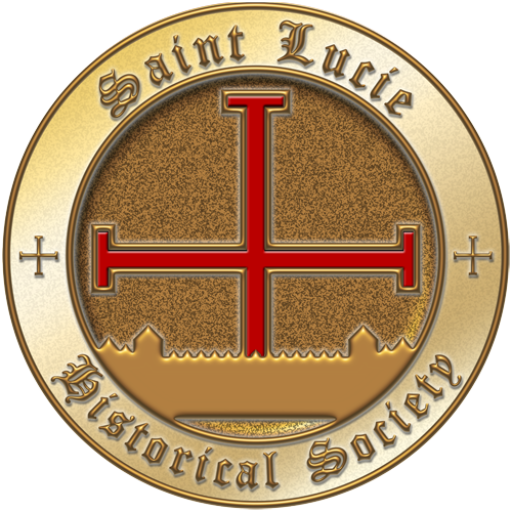Old Timers Letter From 1934
by Charles S. Miley, Ft. Pierce News Tribune Editor Emeritus
A.A. Hendry was one of the first settlers of this area, and one of the pioneer cattleman.
Born near Bartow, he came here with his parents at the age of 14, when there were but a handful of settlers in the area. As was the case with most other early settlers, he engaged in the cattle business during his late youth hood and all his adult life, reportedly being among the largest cattle owners in the state. He and K.B. Raulerson established the East Coast Cattle Co., which later became the Raulerson Cattle Co., forerunner of some of the present-day cattle operations.
He died at the age of 87 and he and his wife are buried in the Fort Pierce cemetery.
A son, A.A. “Buck” Hendry Jr., presently lives at 3576 N. E. Skyline drive, Jensen Beach, but spent most of his life in Fort Pierce and is well known among many of our residents.
When the News Tribune conducted an old timer’s letter writing contest in February of 1934, the senior Hendry wrote a letter relating some of his experiences as an early settler of the area.
Here is the letter:
Fort Pierce, Florida
February 20, 1934
Within less than eight miles of White City, where I hope this will be read as a prize-winning letter, has been my home for 62 years, one month and one week.
For early in January, 1872, my father and mother and eight children left Polk county with two wagons drawn by oxen. After two weeks slow traveling over the government trail, Ft. Meade, Ft. Kissimmee, Ft. Drum, we arrived at Fort Pierce. We drove our cattle with us and camped where night caught us.
We settled on the south side of Ten Mile creek, where later was located the Lisk and Roden grove, later owned by B.J. Selvitz.
Of my father’s eight children, seven are still living, three still in this neighborhood, Mrs. Frank Bell, John Hendry and myself.
At the time of our arrival Henry Parker lived in Fort Drum and Elias Jernigan lived on what is now the Standard Growers grove at Ten Mile; on the south lived Lang on St. Lucie River bluff just south of White City, clearing what has since become the Edwards grove, now owned by Mr. Martin. East was the trading post of the old fort, run by Alex Bell (who arrived the year before) and a Mr. Smith; on the north lived Jim Russel and the Paine family at Ft. Capron. Beyond these points, outside of possible wandering trappers and hunters, there were no settlers short of Ft. Bassenger, Ft. Jupiter, where lived Captain Armour and Mr. Carlin, and Sebastian, where Col. Gibson lived.
An occasional band of Indians stopped on their way to the “fort,” where they would swap deer skins and other hides for beads, cloth, ammunition, salt, etc.
Their main cooking was what they called “sofkee,” -a thick soup soupy mixture of meat, grits, meal, potatoes, beans, or anything they might happen to have, boiled in a copper kettle swung over a slow fire. When done, they would squat around the kettle and pass around the one big spoon for individual use or would gouge out a handful and pour or suck off their fingers. First the bucks would eat till they had enough, then the squaws and pickaninnies. They liked white man’s cooking and lost no opportunity to enjoy it. They were especially fond of milk, never having any milk cows of their own. They would always divide with us whenever they had anything to eat that we did not have.
These Indians were of Old Parker’s band. They were known also as the Cow Creek Indians.
There were about a hundred of them in all. Their headquarters were in the Indiantown section.
September 7, 8, 9, and 10th in the year of 1878, there was a gale with a heavy rain. The Ten Mile creek’s banks overflowed. When the water came up in the floor of our cabin I built a rough boat in the hall and poled my people across the creek to Asbury Sellers’ place. Finding them gone, I became somewhat alarmed. Then I poled on east to John Sellers and spent a night with their family. Next day we all took refuge on the “mound”-still standing, what is left of it, just south of the road about a mile west of Five Mile.
There were 32 of us men, women and children and we spent there two days and one night, We had no shelter and were drenched to the skin. We managed to build a fire which we kept going with driftwood. We brought provisions along but were gladdened by the addition of a deer which swam up and which we killed with a pole. On returning home we found the water had been up two or three feet in the house, according to the marks on the wall.
We lived a rough, hard but healthy life. Plenty of clean food and plenty of outdoor exercise getting it. We had no Sunday schools or churches for years. We soon had a few months school for the younger children and we older ones picked up reading and writing as best we could. Mail, at best, came once a week by sail boat, newspapers were scarce, and magazines were scarcer.
I have seen and used ox carts, mule teams, horse and buggy, railroad cars, and automobiles on land: and the rowboat, sailboat and steamboat on the water; and overhead the airplane. What next?
Yours truly,
A.A. HENDRY, SR.
From “Miley’s Memos.” This article first published 5/7/1978 . Reprinted by permission of the Ft. Pierce News Tribune. “Miley’s Memos” is the property of the Ft. Pierce News Tribune and reproduction of this material is expressly forbidden without the prior written permission of the Ft. Pierce News Tribune © 2002.
